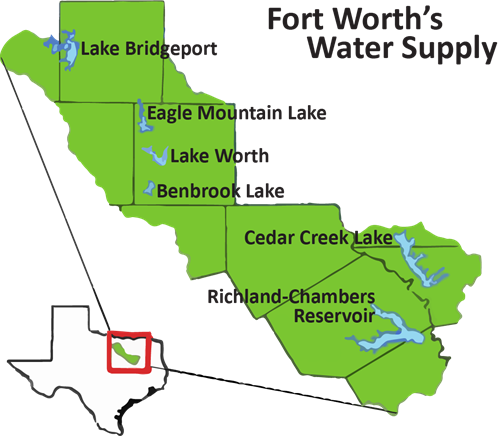Municipal water sources can include surface, ground, and/or recycled water. In Fort Worth, the utility uses 100% surface water from area lakes to provide drinking water.
This section identifies the water sources used to provide you with quality drinking water, details on the water treatment process used by the utility, and information about the staff committed to keeping our water supply safe and reliable.
Where does my water come from?
Supplying water to the nation’s 13th largest city is no easy feat and the challenges going forward as Fort Worth continues to grow will become even greater as demand for water increases. Sure, we see water in many places, such as the lakes, rivers and streams that dot the Texas landscape, and think our water supply is plentiful. That’s not the case. Water is a precious commodity and it takes so much more to get clean, quality water to your kitchen faucet than just pumping it from those sources.
Currently, Fort Worth’s water supply comes from Lake Worth, Lake Bridgeport, Eagle Mountain Lake, Benbrook Lake, Richland Chambers Reservoir, Cedar Creek Reservoir and the Clear Fork of the Trinity River. Fort Worth owns Lake Worth, and Benbrook Lake is the responsibility of the U.S. Army Corps of Engineers. The Tarrant Regional Water District (TRWD) owns and operates the four remaining lakes.

Microorganism testing shows low detections in raw water
Tarrant Regional Water District monitors the raw water at all intake sites for Cryptosporidium, Giardia Lamblia and viruses. The source is human and animal fecal waste in the watershed.
The 2023 sampling showed occasional low level detections of Cryptosporidium, Giardia lamblia and viruses in some but not all of the water supply sources. These are either deactivated or removed through disinfection and/or filtration.
TCEQ assess raw water supplies for susceptibility
The Texas Commission on Environmental Quality completed an assessment of Fort Worth’s source waters. TCEQ classified the risk to our source waters as high for most contaminants.
The sampling requirements for Fort Worth’s water system is based on this susceptibility and previous sample data. Any detections of these contaminants are found in this water quality report.
For more information on source water assessments and protection efforts at our system, contact Stacy Walters at 817-392-8203.
Further details about the source-water assessments are available in the Texas Commission on Environmental Quality’s Drinking Water Watch database at bit.ly/TCEQDWW2021.
Rainfall and lake levels
Locally, the average annual rainfall totals about 37 inches compared to just over 40 inches a year south of Dallas where Richland Chambers and Cedar Creek reservoirs are located.
TRWD constructed Cedar Creek Lake in the 1960s, and in 1972, the Rolling Hills plant began treating drinking water. In 2021, the city bought 76.3 billion gallons of raw water from TRWD.
Fort Worth can treat about 500 million gallons of drinking water a day. The utility provides water to more than 1.3 million people in Fort Worth and surrounding communities.
Potential Raw Water Impurities
Contaminants found in drinking water may cause taste, color, or odor problems. These types of problems are not necessarily causes for health concerns. For more information on taste, odor, or color of drinking water, please contact customer service at 817-392-4477.
Drinking water, including bottled water, may reasonably be expected to contain at least small amounts of some contaminants. The presence of contaminants does not necessarily indicate that water poses a health risk. More information about contaminants and potential health effects can be obtained by calling the EPA’s Safe Drinking Water Hotline at 800-426-4791.
As water travels over the surface of the land or through the ground, it dissolves naturally occurring minerals and, in some cases, radioactive material, and can pick up substances resulting from the presence of animals or from human activity.
Microbial contaminants, such as viruses and bacteria, which may come from sewage treatment plants, septic systems, agricultural livestock operations, and wildlife.
Inorganic contaminants, such as salts and metals, which can be naturally-occurring or result from urban stormwater runoff, industrial or domestic wastewater discharges, oil and gas production, mining, or farming.
Pesticides and herbicides, which may come from a variety of sources such as agriculture, urban storm water runoff and residential uses.
Organic chemical contaminants, including synthetic and volatile organic chemicals, which are by-products of industrial processes and petroleum production, and can also come from gas stations, urban storm water runoff, and septic systems.
Radioactive contaminants, which can be naturally-occurring or be the result of oil and gas production and mining activities.
In order to ensure that tap water is safe to drink, the EPA prescribes regulations that limit the amount of certain contaminants in water provided by public water systems. Food and Drug Administration regulations establish limits for contaminants in bottled water that must provide the same protection for public health.
Conservation is a Water Source
Water is a limited resource in the West and Fort Worth is no exception. While building new lakes seems like a simple solution to increasing water supply, the reality is lake construction is a massive financial and planning venture. The construction of any new lake would need to take place east of Fort Worth, where rainfall is more plentiful. Nevertheless, this would still increase the infrastructure needed and future water costs to pump the water back West.
A painless solution is to save the water we have through conservation. According to the current State Water Plan, water conservation strategies will supply approximately 25% of our future water. Fort Worth Water added a conservation section in 2008 and has since worked hard to extend resources.
Fort Worth has a series of “Smart” programs that advance water conservation. These are available to all Fort Worth water account holders. Conservation also supports the city’s maximum twice a week watering schedule adopted by City Council in 2014. Fort Worth’s watering schedule has been instrumental in reducing local water needs. For more information, visit savefortworthwater.org.